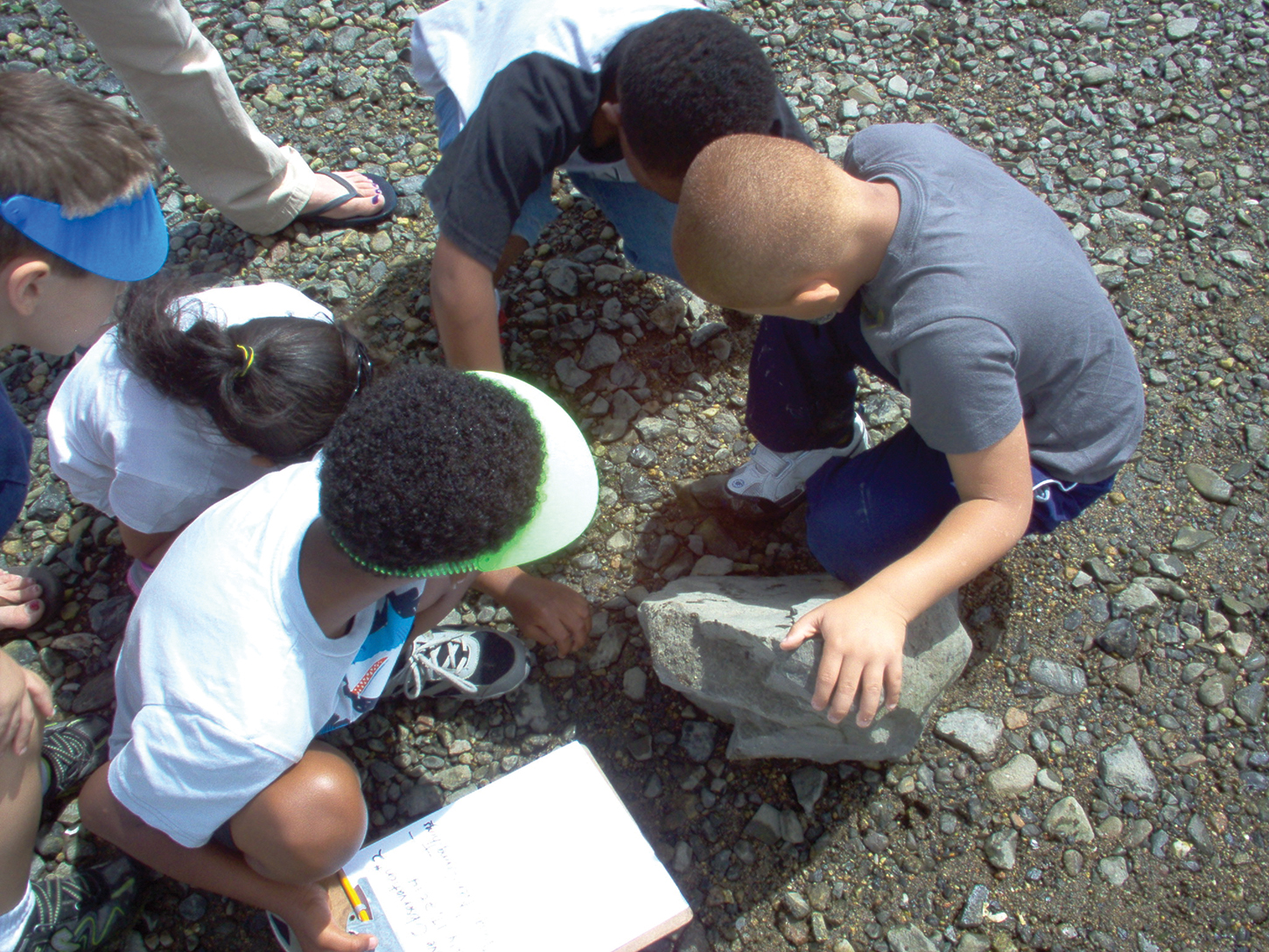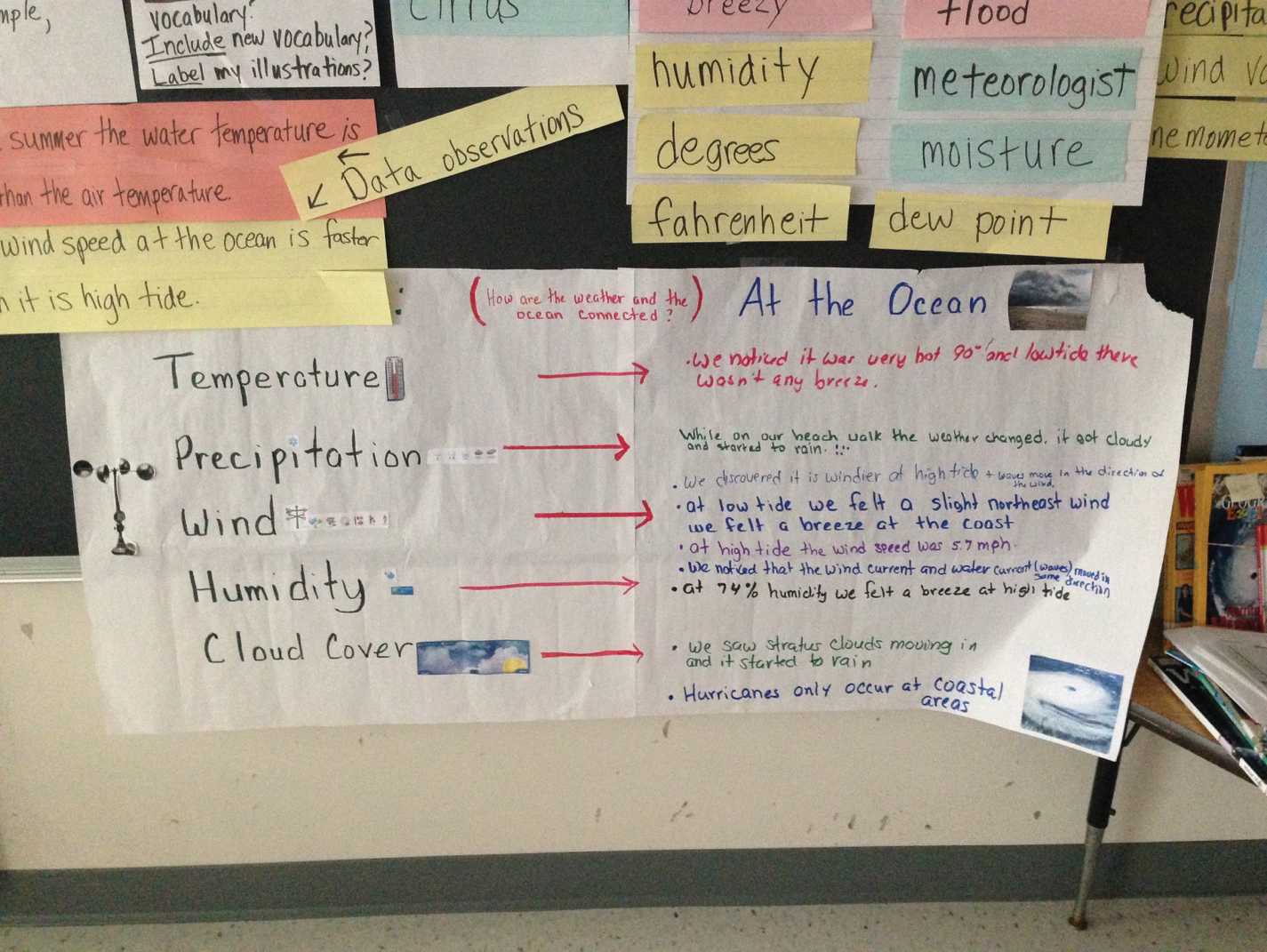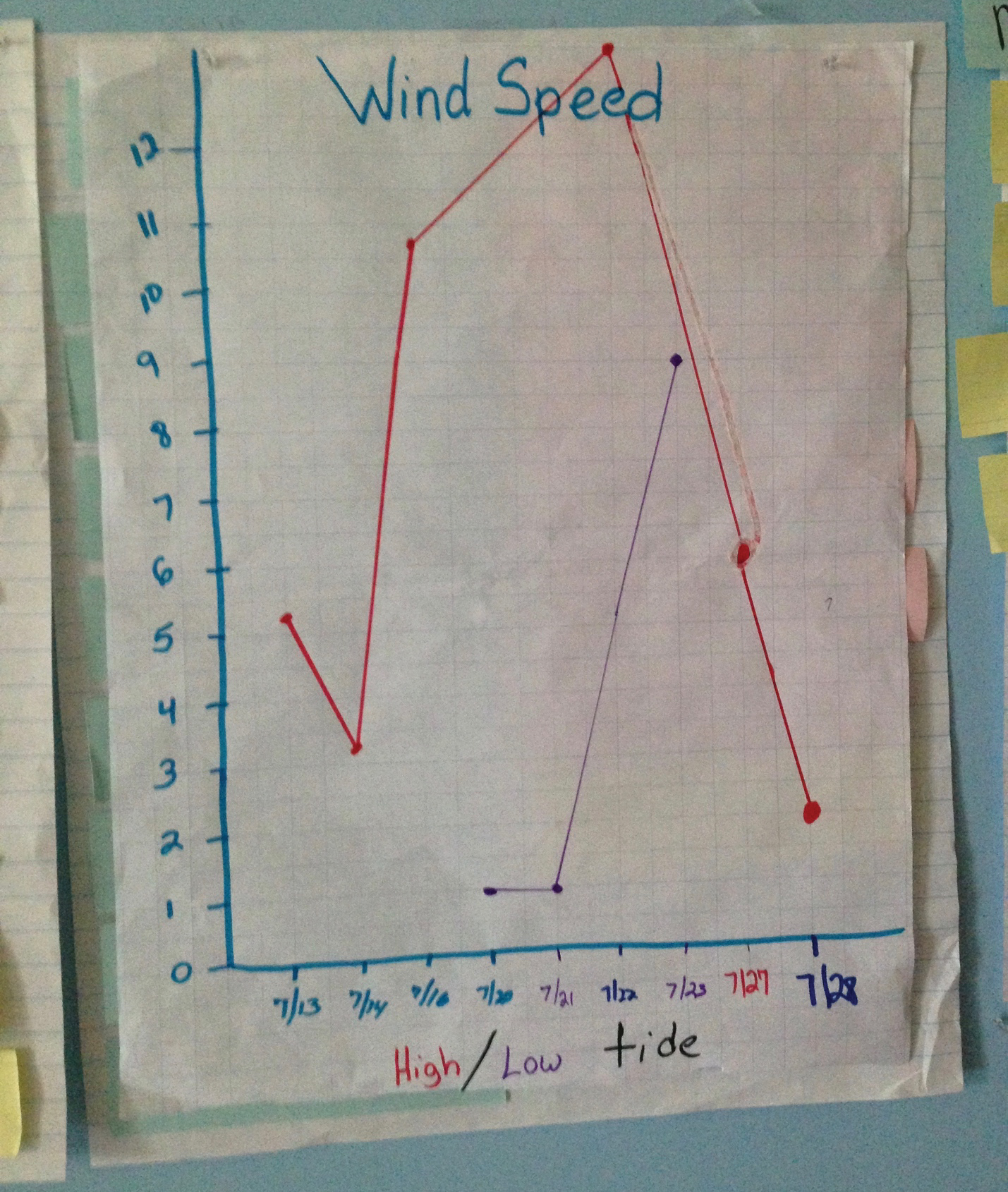Teaching Teachers
Learning Science and Literacy Together
Professional learning that supports disciplinary literacy instruction for our youngest learners
Learning Science and Literacy Together
By Jacy Ippolito, Cami Condie, Jaclyn Blanchette, and Cleti Cervoni
Each summer, one elementary school nestled along the New England coast is bustling with elementary students. The students are predominantly English learners (ELs), all of whom struggle with reading, writing, and communication skills. The students are participating in a four-week summer program focused on increasing literacy skills through scientific investigations. For these students, this is an opportunity to become young scientists. For their teachers, however, this is an annual professional learning opportunity, in which they gather to improve their own teaching of science content and literacy processes. Before talking about teacher learning, let’s first look at student learning.

A Snapshot of Students’ Summer Learning
On a typical day in our summer program, we might see third graders hurrying to the ocean to observe and record the weather before returning to school to read their daily weather report on the school’s loudspeaker. Acting as scientists, they create windmill anemometers and learn to calculate wind speed, use various thermometers to measure water and air temperature, and use the language of oceanography (e.g., high/low tide). Later, in their classrooms, they study wind direction and the implications for local boaters and fishermen. Finally, students learn about forecasting and presentation skills by watching and reading transcripts from a local television station’s weather forecast.
All of these experiences are designed to reflect the real-life work of scientists. By combining science and literacy instruction within authentic inquiry-based tasks, suddenly we see struggling readers enthusiastically embracing scientific responsibilities and blossoming as readers and writers.
Perhaps more importantly, we see the teachers eager to improve both their science and literacy instructional skills, learning to engage students in disciplinary literacy tasks. While the benefits of the summer program are clear for students and their families, the professional learning opportunities for teachers may not be as obvious. Having studied and led this program over five years, we have come to believe that this model has great potential to benefit teachers. To begin, let us discuss the importance of disciplinary literacy as a useful framework for guiding professional learning.
Why Disciplinary Literacy?
With the implementation of both the Common Core State Standards (CCSS) and the Next Generation Science Standards (NGSS), a shift in elementary science and literacy instruction is underway. Educational researchers have begun to use the term disciplinary literacy (Shanahan and Shanahan 2014) to refer to the ways in which students learn to read, write, and communicate in content-area classes, as budding historians, mathematicians, and scientists. Taking a disciplinary literacy stance toward science instruction is both promoted and reinforced by CCSS and NGSS, which encourage instructional practices that support students in adopting habits of mind and specific strategies that approximate the work of real scientists.
While disciplinary literacy instruction has been primarily promoted as a way of supporting adolescents’ scientific content and literacy learning (Pearson, Moje, and Greenleaf 2010; Shanahan 2004), researchers and teachers have recently begun to extol the virtues of disciplinary literacy instruction for our youngest students (Brock et al. 2014; Cervetti and Pearson 2012; Ippolito et al. 2017; Shanahan and Shanahan 2014). While disciplinary literacy instruction in secondary science classes may focus more on reading and writing complex texts, with particular attention to discipline-specific academic vocabulary, language conventions, text structures, and deciphering visual representations, educators focusing on disciplinary literacy instruction for younger learners might focus more on inquiry-based instruction, encouraging particular disciplinary habits of mind, and expanding our definition of what counts as “text” (e.g., field guides, data representations, handbooks, etc.) (Cervetti and Pearson 2012, p. 584).
Even as some educators are encouraging a disciplinary literacy approach to early science instruction, there is a shortage of preservice and inservice professional learning experiences aimed at helping elementary teachers learn and model scientific literacy habits of mind and practices with young students. Over the past handful of years, we have asked ourselves: What does excellent science disciplinary literacy professional learning look like for both new and experienced elementary school teachers? Which professional learning models best serve both teachers and students?

We believe we have found one answer to these questions in the form of our summer program that simultaneously bolsters students’ science and literacy skills and supports teachers in learning how to interweave scientific and literacy instruction.
Influencing Yearlong Teaching Through Summer Professional Learning
As part of a district-university partnership, our summer program was designed to support rising students in grades 1 to 5 who did not meet end-of-year reading benchmarks. More than 200 elementary students and 30 teachers have participated in this program, averaging 55 children per summer (with some children participating more than once). While students and teachers were selected by the school district, we supported the teachers in designing and implementing the program’s science and literacy content. As university partners, we also directed teacher professional learning.
The professional learning component of the summer program took two forms: (1) a pre-program introduction to a disciplinary literacy framework for supporting students’ science and literacy learning; and (2) ongoing daily collaborative refinement of teaching practices. By spreading the professional learning experience across the entire four-week summer program, teachers were able to receive just-in-time support in tailoring their instruction to meet students’ scientific literacy needs.
Initially, teachers were introduced to and used the Pearson, Moje, and Greenleaf (2010) multimodal approach to plan opportunities for students to do science, talk science, read science, and write science. Using this framework, teachers provided students with opportunities to think like scientists on field trips to the nearby ocean (e.g., observing, taking and comparing notes, collecting data). Together with the doing activities (hands-on scientific investigations), teachers engaged students in evaluating scientific ways of reading and writing, or science disciplinary literacy.
For example, our third-grade meteorologists read news transcripts to identify the structure and content of weather reports. They noticed that professional meteorologists share the day’s temperature, determine wind speed and direction, provide implications for clothing and activity choices, and then make evidence-based predictions (e.g., if the weather in the morning would be the same in the evening; if many people would be seen at the mall or at the beach that day). Using this structure as a mentor text, or template, the students then drafted and revised their own daily class weather report with their collected weather data to be presented to other summer program participants. As students became more comfortable delivering their reports, our young meteorologists returned to the news transcripts to record specific language choices used by meteorologists (e.g., temperature, wind direction, high/low tide) to include in both their data collection and weather reports. Questioning why scientists made specific reading and writing decisions, and then evaluating their own authoring decisions within their daily reports, helped our young learners make meaningful connections between the hands-on science investigations and their own purposeful reading and writing opportunities.
This evaluation of scientists’ writing purposes and craft, followed by writing, revising, and presenting weather reports based on their own data collection, met many third-grade Common Core literacy standards, and introduced our third graders to several fourth-grade standards (NGAC and CCSSO 2010):
- RI.3.1 Ask and answer questions to demonstrate understanding of a text.
- RI.3.10 Read and comprehend complex, informational texts (technical texts).
- L.3.6 Acquire and use accurately domain-specific words and phrases.
- W.3.2 Write informative texts to examine a topic.
- W.3.8 Gather information from print and digital sources.
- R.I.4.5 Describe the overall structure of a text.
- RI.4.7 Interpret information presented visually and explain how the information contributes to an understanding of the text.
- W.4.4 Produce clear and coherent writing in which the development and organization are appropriate to task, purpose, and audience.
- W.4.7 Conduct short research projects that build knowledge through investigation of different aspects of a topic.
The weather report creation also included many habits of real scientists. When scientists read they rely on data, determine the validity of sources and quality of evidence, make predictions, and review and reject information (Shanahan 2012). In their writing, they communicate in a systematic format and distinguish facts from opinions. Scientists allow curiosity to drive their learning, look for connections, and propose explanations.
For teachers and students, disciplinary literacy work includes asking questions of and evaluating the work of scientists as readers and writers. Learning how to ask such literacy-focused evaluative questions is a skill that can be applied to other scientific texts as well: “Why does a scientist include the ‘materials section’ in a lab report? How was data collected, and is the data trustworthy? For what purpose does a scientist take detailed observation notes? What kinds of descriptive words help to differentiate what was collected?” When students mirror scientists’ professional ways of thinking and working, they are learning in authentic and engaging ways, developing both scientific content and literacy knowledge.
Initial teacher professional learning was supplemented by daily, end-of-day group discussions about teaching dilemmas. Dilemmas served as formative assessments, both of our teaching and of student needs. Dilemmas included clearly defining students’ content needs, determining textual opportunities for learning, and supporting hands-on experiences to build content knowledge or combat misconceptions. Teachers were supported by university coaches as they brainstormed solutions and subsequently implemented strategies to encourage content synthesis and disciplinary reading and writing. For example, one teacher noted that her students were “not quite feeling like experts” about their class essential question: “Is our local harbor healthy?” After brainstorming as a team, the teacher decided to guide her young scientists to ask more specific questions, to consider what a reader would want answered in a field guide, and to help students better use their texts to check their thinking. She implemented those ideas and later realized that she also needed to model “taking ownership of your thinking. As authors, students need to write what they believe they have evidence to support.” A few weeks later, the teacher reflected:
Today we visited another part of our harbor.…It was amazing to see how naturally [each student] jumped into exploring our essential question. There was very little prompting needed for them to take off on their own as scientists.…The students are wrapping up their projects, and it’s amazing to see how much they’re writing. Now the ideas are flowing. They are so confident in their abilities.
Her students were becoming scientists, feeling ownership of their research question, able to defend their thinking with evidence and confidence. Student work and class discussions became the formative data used to determine next steps. This diagnostic professional learning was determined by the needs both we, as directors of the program, and teachers themselves observed in classrooms and across student work samples.
Ultimately, the pre- and in- program professional learning (as well as on-the-job experience of teaching science and literacy simultaneously, unencumbered by many of the daily pressures of teaching during the school year) allowed teachers within this program to think expansively about science disciplinary literacy. Across focus groups, individual interviews, and video-recorded observations, we have found a stunning array of science disciplinary literacy instructional practices in these teachers’ classrooms during the school year. One teacher added more research and writing to his first- and second-grade unit on Moon phases. His past explorations included modeling the Moon phases with flashlights and watching kid-friendly videos about the topic. He said:
I wanted to have my students coming up with questions, and us finding answers. It never was something that I would follow through with 100%.…We still had a bunch of unanswered questions. We never really wrapped those questions up. They never really had anything that they could hold, that said that they researched and answered their own questions. It used to be a lot more teacher-directed.
Now the teacher added scientific reading and writing based on students’ brainstormed wonderings (e.g., “I wonder how or if the Moon makes night”) and reading across sources to determine answers to student-generated questions. The teacher hoped that students would find contradictory information in their sources so that they could learn to read critically, evaluate accuracy, and record the discrepancy as contradictory across sources or decide which source included the most trustworthy information.

His Moon investigators explored and defended the accuracy of their wonderings in small research groups using a variety of texts from the internet and trade books. Frequently, students pointed to the text, making connections to their wonderings. For example, “This part says the moon does not make night, and that means our wondering wasn’t right.” Students read from these texts (most above their reading and grade level), documenting their findings and citing the author as they recorded their answers. Students were heard sharing with the research team, “This book says the same thing as this article.”
Corroborating findings with and across published research reflects the work of scientists. These young scientists researched to defend their wonderings (emerging hypotheses), evaluated various sources to find answers, and presented their investigations to peers based on cited research. For our summer program teachers, having the time and freedom to explore and refine disciplinary literacy practices during the summer program seems to have helped the teachers transport the same practices back to their regular classrooms.
Results for Students and Teachers
Our summative assessment results, in the form of reading assessments (e.g., Fountas and Pinnell’s Benchmark Assessment System), demonstrated considerable student growth in literacy and in science content knowledge over the course of the program. In particular, students averaged three-to-four months of growth on reading assessments after only four weeks. Their vocabulary, presentations, and advocacy letters demonstrated their growing knowledge of their studied science topic. It seems that the authentic, inquiry-based nature of the summertime instruction, fueled by the teachers’ ongoing professional learning, might partially explain the increased student growth in reading achievement. After participating in the summer program, we wondered about the extent to which teachers brought science disciplinary literacy practices into their school-year classrooms. To investigate, we formally visited teachers’ classrooms during the school year at least two times during two different science units and informally as schedules allowed. Several themes emerged.
First, teachers continued to value authentic opportunities to engage in organic professional learning opportunities. As university partners, during the summer, we matched teachers’ diagnostic-focused instruction with diagnostic-focused professional learning. In other words, the daily professional learning topics and conversations emerged from the daily teaching. This held true for many teachers during the school year, as they continued to collaboratively investigate problems of teaching practice related to their instruction of science and literacy content. During their regularly scheduled common planning time, the first- and second- grade team now focused explicitly on their students’ scientific reading and writing as well as planning hands-on experiments. Moving away from rote copying of short definitions into science journals, low-stakes matching labels and diagrams, or posing a question without confirming or disproving it, these teachers asked their young scientists to read more complex texts in collaborative research teams and wrestle with contradictory information in order to build knowledge and confirm findings.
Second, teachers reported that disciplinary literacy approaches promoted deeper understanding of content for both themselves and their students. Throughout the inquiry process, there were natural opportunities to explore concepts and student-driven questions in targeted ways. Teachers became more comfortable with the messiness of not knowing all the answers. Particularly, in upper-grade classrooms, the students often became more expert on a topic than the teachers, allowing teachers to become facilitators and coaches instead of knowledge-dispensers. As a result, students had more to write and discuss during science-based work sessions. Student questions became more meaningful and discussions more complex. Explorations (through text-based and hands-on research) became more important because the focus was on answering student-generated questions. For both teachers and students, content knowledge and the literacy strategies used to gain content knowledge became deeper and more nuanced.
Third, implementing disciplinary literacy practices and principles led to greater student autonomy and independence. Teachers described needing to “get out of the way” of student learning. “We can find out,” and “We need to record this data so that we remember what we found” became common student refrains, especially among the youngest learners and those identified as most struggling. Inquiry-based work became the norm as students took ownership of their science literacy work, reflecting the processes of professional scientists.
Ultimately, given the benefits of the summer program to both students and teachers, we are eager to see this model continue, as well as expand to other schools and districts. Encouraging science disciplinary literacy for our youngest learners can and should be a priority. Just as important, programs such as this must continue to be rich contexts in which teacher professional learning can flourish.


